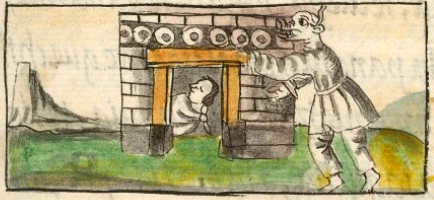tlacatecolotl (FCbk10f21r)
This iconographic example, featuring a shape-shifting person or human-horned owl (tlacatecolotl), is included in this digital collection for the purpose of making comparisons with related hieroglyphs. The term selected for this example comes from the text on the same page as the image in the Digital Florentine Codex. There is no gloss, per se. We have extracted this anthropomorphic male figure from the scene in which he appears, so look at the contextualizing image for more information. This tlacatecolotl has the head of a pig or boar, with a long snout, mouth open, and teeth showing. He is standing, mostly in profile, facing left. He is fully clothed in a European man’s belted tunic and trousers, and he is barefooted. The clothing has gray shading to give it a three-dimensionality (also showing European influence). He is reaching forward toward a house with a sleeping man inside. Thus, this man-animal appears threatening and frightening.The text not only names him with the word that came to mean devil or demon (tlacatecolotl) in Christian doctrine, but the text states that he could turn himself into a nahualli (“mocuepani naoale,” which Anderson and Dibble translate as someone who “transforms himself, who assumes the guise of an animal”). These are obviously challenging terms to translate cross-culturally.
Stephanie Wood
Examples of the tlacatecolotl in this collection, which in two instances–somewhat surprisingly–involve personal names, show animal-like heads with horns. Glyphs relating to the nahualli in this digital collection can be a caterpillar, cocoon, chrysalis, or pupa (which by nature are shape shifters) or various animal heads such as those of a bird, a coyote, or a serpent, riding on top of a human head, as though part of the person’s identity.
Stephanie Wood
Tlacateculutl
tlacatecolotl
Stephanie Wood
1577
Jeff Haskett-Wood
nahuales, diablo, diablos, demonio, demonios, hombre-tecolote, hombres-tecolotes, hombre poseído, hombres poseídos
tlacatecolo(tl), “human horned owl,” or a nahualli, which Christians renamed the devil, demon, sorcerer, etc., https://nahuatl.wired-humanities.org/content/tlacatecolotl
el hombre-búho
Stephanie Wood
Available at Digital Florentine Codex/Códice Florentino Digital, edited by Kim N. Richter and Alicia Maria Houtrouw, "Book 10: The People", fol. 21r, Getty Research Institute, 2023. https://florentinecodex.getty.edu/en/book/10/folio/21r/images/0 Accessed 5 September 2025.
Images of the digitized Florentine Codex are made available under the following Creative Commons license: CC BY-NC-ND (Attribution-NonCommercial-NoDerivs 4.0 International). For print-publication quality photos, please contact the Biblioteca Medicea Laurenziana ([email protected]). The Library of Congress has also published this manuscript, using the images of the World Digital Library copy. “The Library of Congress is unaware of any copyright or other restrictions in the World Digital Library Collection. Absent any such restrictions, these materials are free to use and reuse.”







